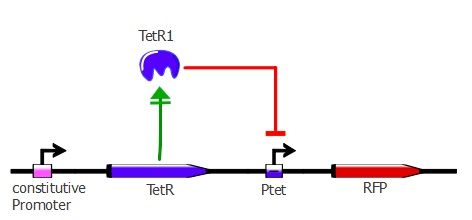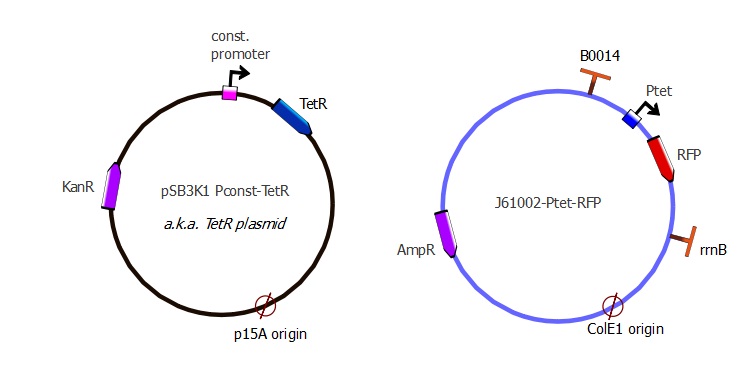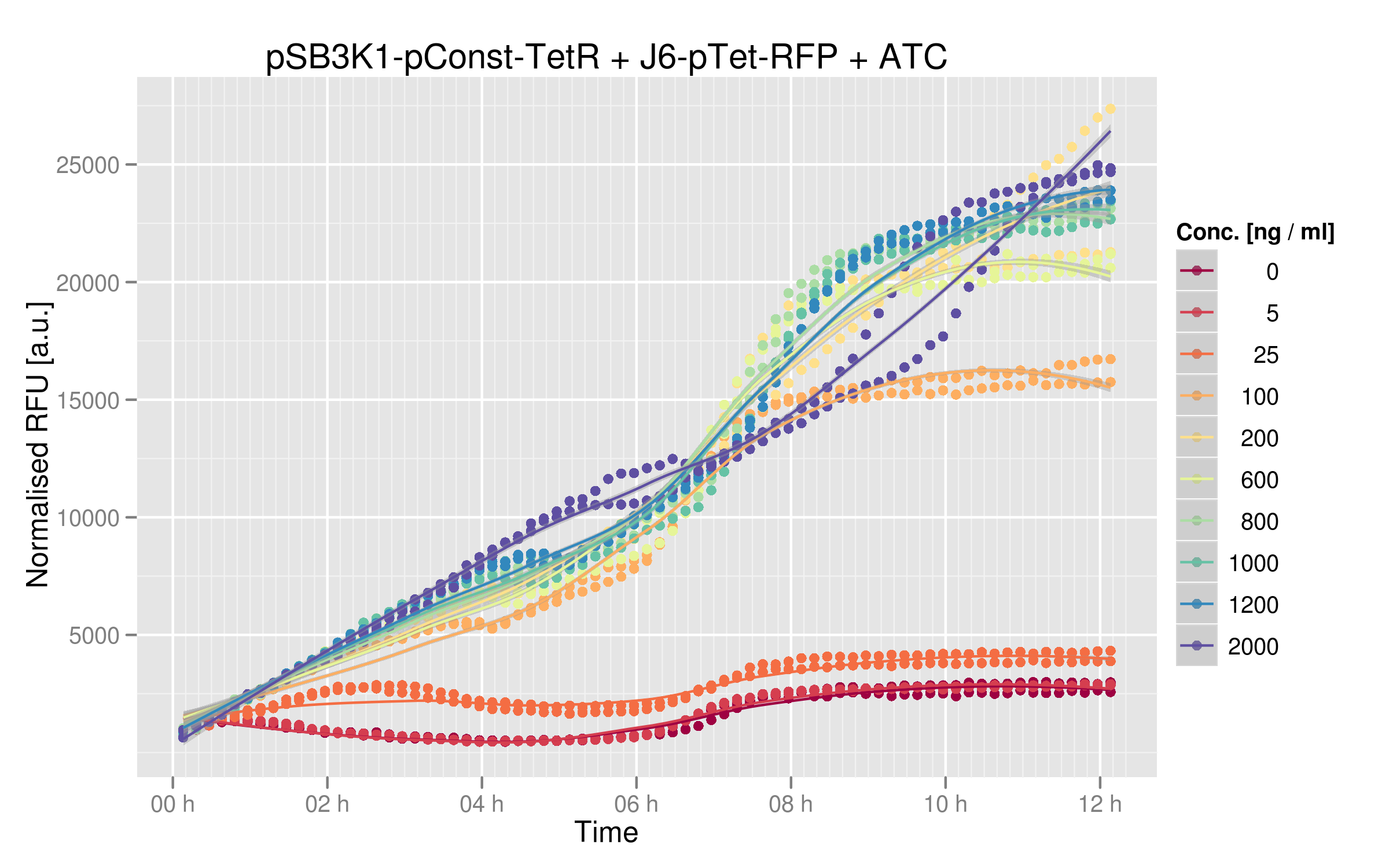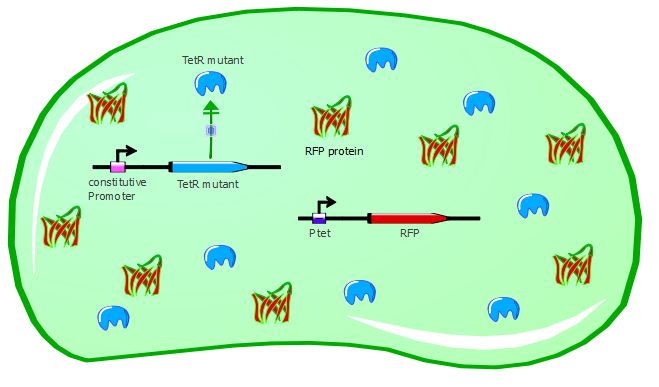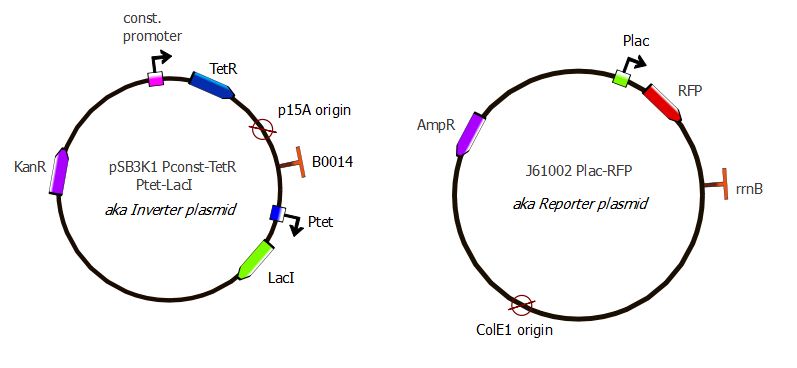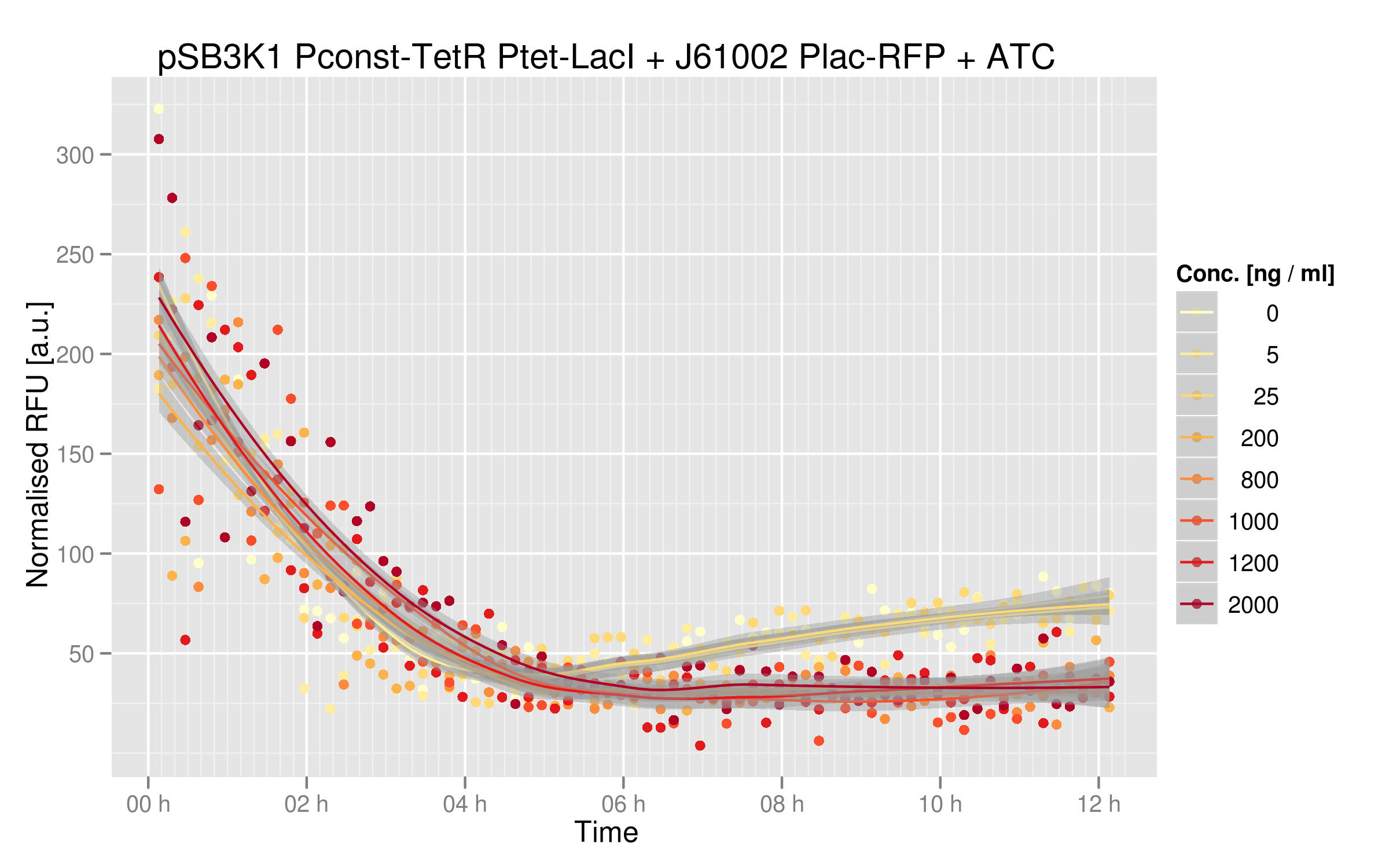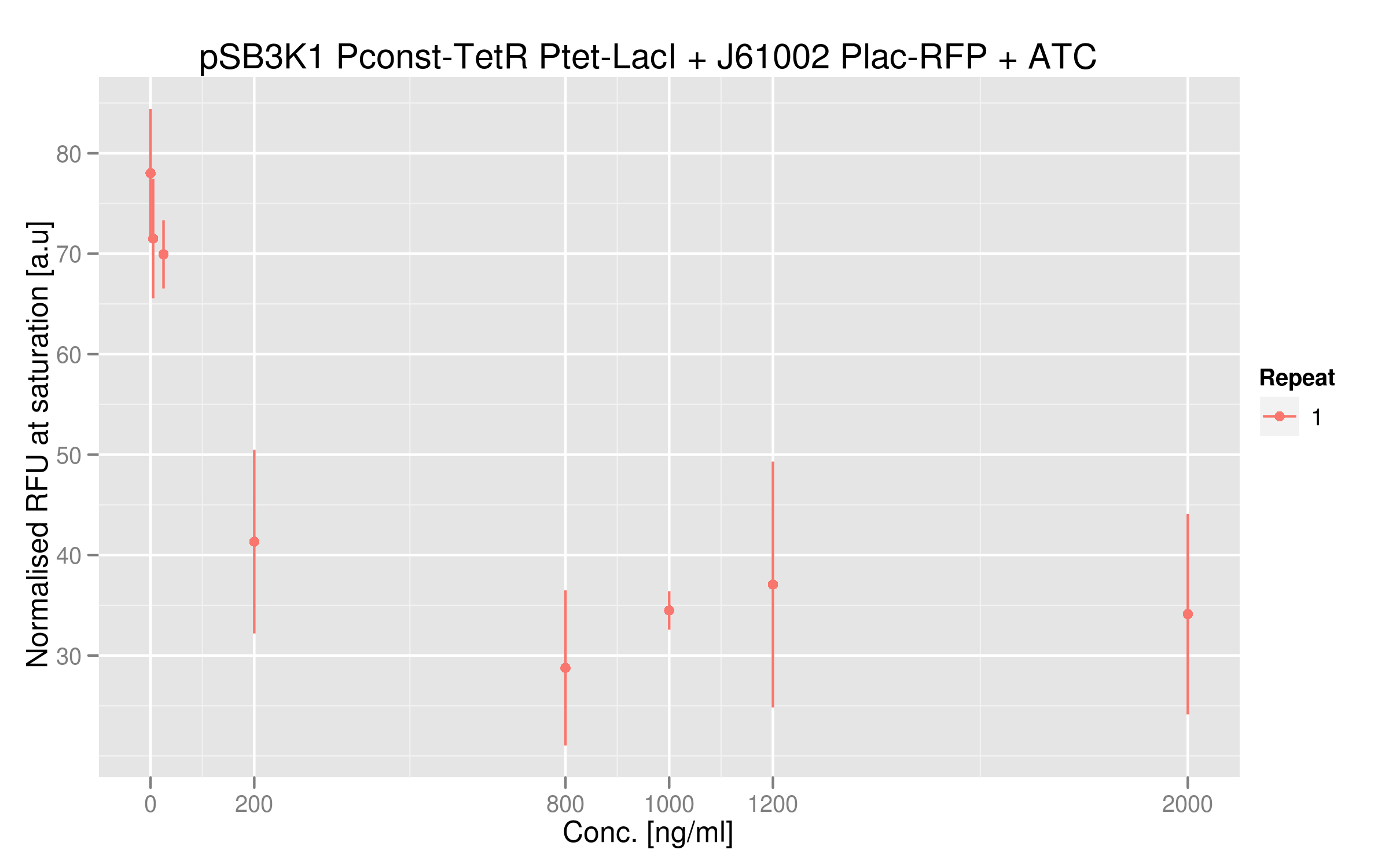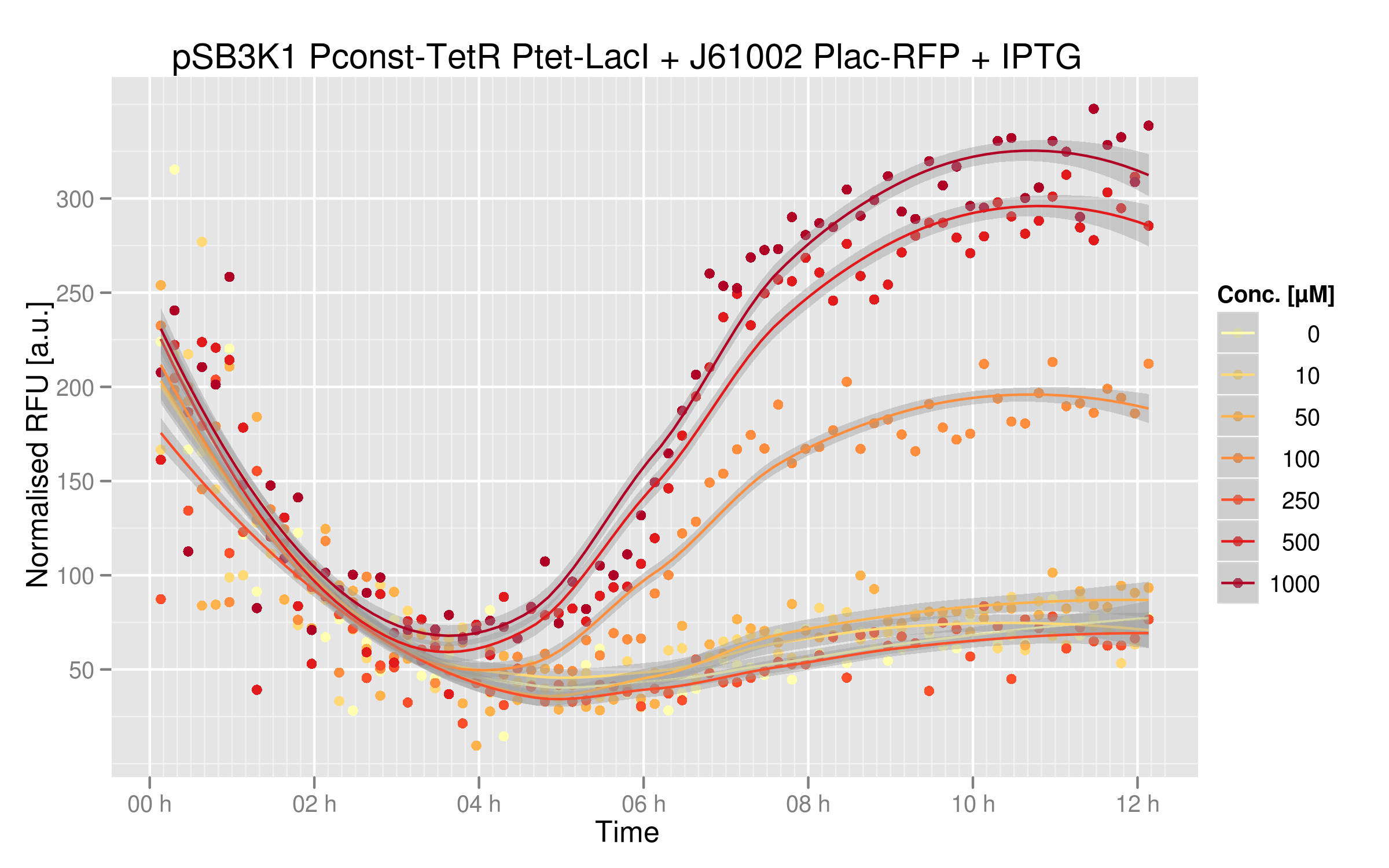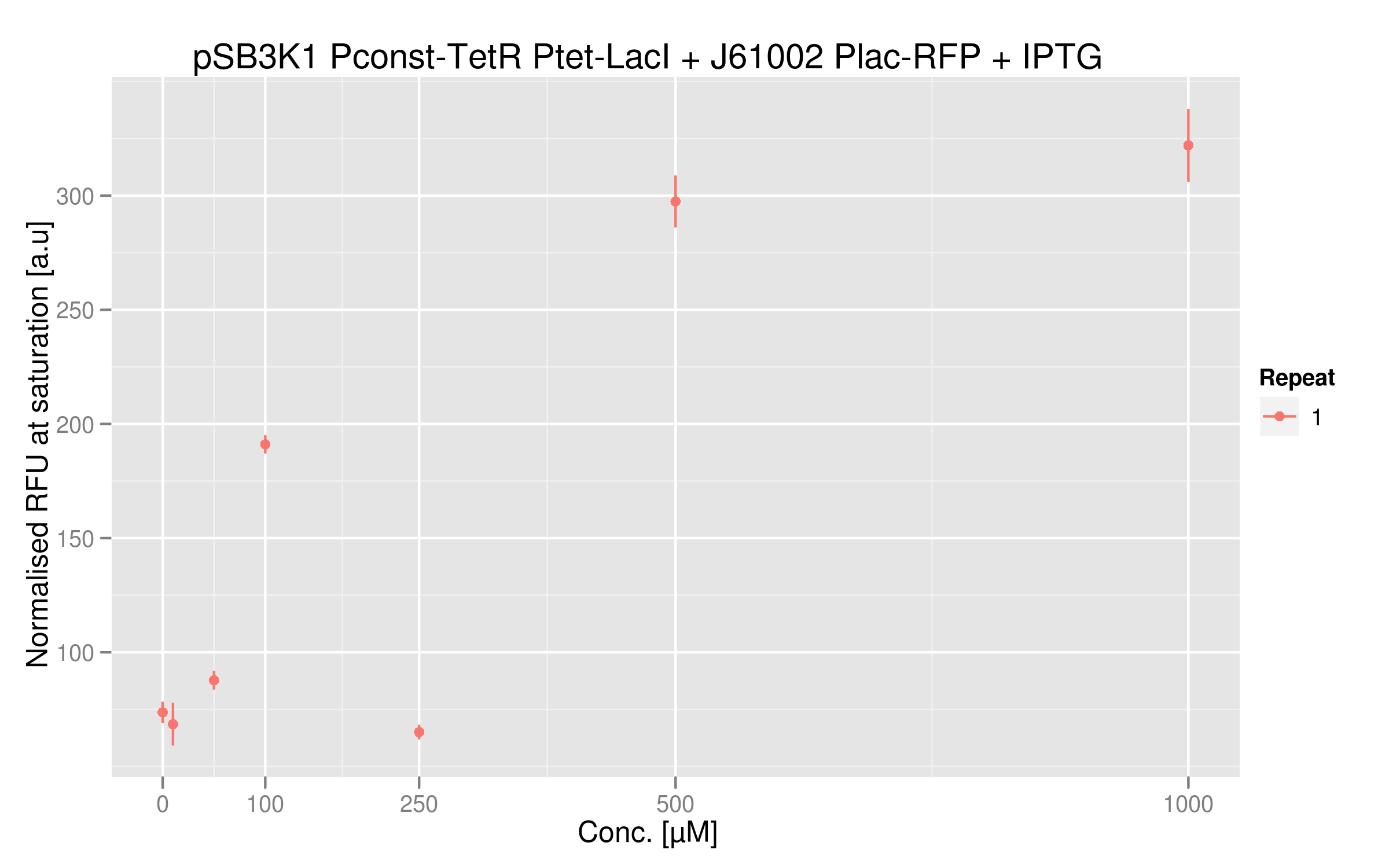Team:EPF-Lausanne/Our Project/Assembly
From 2011.igem.org
| Line 84: | Line 84: | ||
=== Experimental validation - with wild-type TetR === | === Experimental validation - with wild-type TetR === | ||
| - | Our second readout system | + | Our second readout system was based on TetR and LacI, where we repressed both sequentially with ATC and IPTG, respectively. |
| Line 99: | Line 99: | ||
| - | Below you can see the induction curves | + | Below you can see the induction curves at different ATC concentrations added to the growth medium: |
[[File:EPFL_Nadine-exp4-induction.png|600px]] | [[File:EPFL_Nadine-exp4-induction.png|600px]] | ||
| - | With | + | With zero or low concentrations of IPTG in the cells' medium, RFP expression is quite weak; this can be explained by the fact that Ptet was mutated in our plasmids and thus TetR couldn't repress LacI very efficiently. In normal conditions, we should see RFP expression when TetR binds to Ptet - which is the case here, since we have the wild-type TetR gene. Here, LacI was not well repressed by TetR, thus RFP is repressed even when TetR binds to Ptet. |
| - | Nevertheless, there is a decrease in RFP expression when we add sufficient amounts of ATC. Even in our mutated system, TetR interaction | + | Nevertheless, there is a decrease in RFP expression when we add sufficient amounts of ATC. Even in our mutated system, TetR interaction with Ptet still has an effect on the output. There is a 2-fold difference between high ATC concentrations and zero ATC; we believe that by restoring the Ptet sequence, this difference would be higher. |
''ATC dose-response curve'' | ''ATC dose-response curve'' | ||
| Line 115: | Line 115: | ||
''IPTG induction'' | ''IPTG induction'' | ||
| - | IPTG will inactivate LacI, so that RFP will be more '''expressed'''. | + | IPTG will inactivate LacI, so that RFP will be more highly '''expressed'''. From this we expect an increase in RFP expression with increasing IPTG concentration in the medium. |
Gene expression in the cell without IPTG: | Gene expression in the cell without IPTG: | ||
| Line 129: | Line 129: | ||
[[File:EPFL_Nadine-exp5-induction.png|600px]] | [[File:EPFL_Nadine-exp5-induction.png|600px]] | ||
| - | Indeed,RFUs increase 8-fold between | + | Indeed, RFUs increase 8-fold between zero IPTG and the highest concentrations. Note that the RFU intensity for the curve with no IPTG matches the intensity of the curve with no ATC in the ATC induction experiment, showing that these two experiments are consistent. The curves with the highest IPTG concentrations are not overlapping, showing that we could repress LacI even further at higher IPTG concentrations. |
You can compare these results with the characterization of [https://2011.igem.org/Team:EPF-Lausanne/Our_Project/Assembly/Plac Plac alone]. Without IPTG, RFP expression is much lower than the real Plac strength; our system does react strongly to LacI expression. | You can compare these results with the characterization of [https://2011.igem.org/Team:EPF-Lausanne/Our_Project/Assembly/Plac Plac alone]. Without IPTG, RFP expression is much lower than the real Plac strength; our system does react strongly to LacI expression. | ||
Revision as of 08:58, 21 September 2011
Reporter Systems
The last step of our overall strategy is to characterize in vivo the affinity and specificity of our TetR mutants. To that end, we set up two reporter systems based on RFP fluorescence.
Skip to details about:
Contents |
TetR - RFP system
Description
The first system is the simplest one; it is composed of TetR driven by a constitutive promoter with RFP (red fluorescent protein) under Ptet control. If TetR binds to Ptet, then RFP is repressed. By applying different concentrations of ATC (anhydrotetracycline) to the cells, RFP is expressed - the stronger the TetR mutant binds to Ptet, the higher the ATC concentration needed to have full expression of RFP.
The TetR and RFP genes were put on two different plasmids: pSB3K1 pConst-TetR and J61002 Ptet-RFP. For more details about them, please refer to the Plasmids details page.
Experimental validation - with wild-type TetR
ATC induction
To validate our first readout system, we performed platereader experiments with different concentrations of anhydrotetracycline (ATC). This molecule binds to the TetR dimers and induces conformational changes that make the transcription factor unable to bind to Ptet. As a result, RFP can be expressed.
Gene expression in the cell without ATC:
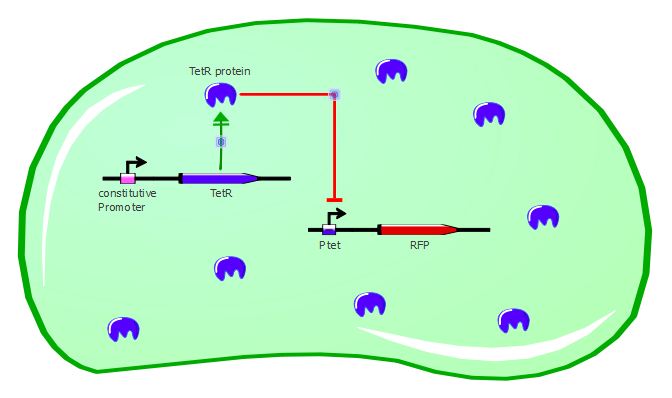
Gene expression in the cell with ATC:
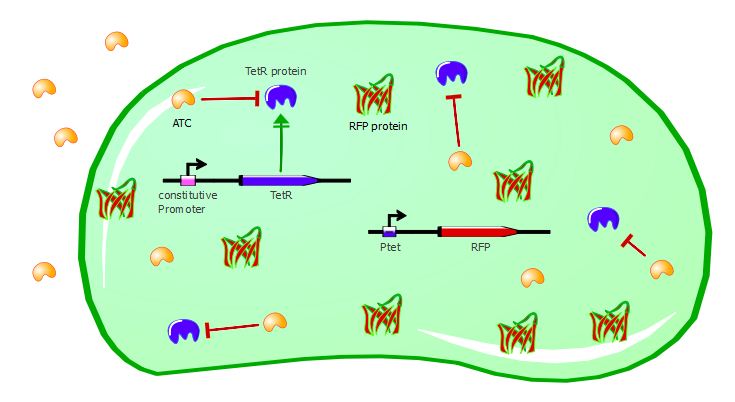
Here are the results of our ATC induction experiment:
The induction curves show that RFP expression increases with addition of ATC. In the absence of ATC, cells express about 2500 normalized RFUs (relative fluorescence units) when they reach a plateau, whereas at the highest concentrations of ATC we observe 25'000 normalized RFUs. There is a 10x difference between normal medium (without ATC) and addition of ATC, showing that our first readout system is sensitive to ATC concentration. Moreover, expression of RFP in cells without ATC is 10-fold lower than the values obtained for Ptet characterization alone.
We can reasonably assume that this system can be used for in vivo screening: TetR mutants that are not capable of recognizing the consensus Ptet sequence will yield more RFP expression than other mutants that can still recognize Ptet.
Dose-response
By looking at the dose-response graph, we can see a significant increase between 0 and 200 ng/microL ATC; then the RFU values begin to plateau. The graph shows that the TetR-Ptet interaction has a strong impact on RFP expression. The highest RFUs measured here correspond to the levels of the Ptet-RFP construct alone (in the absence of the the TetR plasmid), showing that we can obtain complete TetR suppression in our experiments.
TetR mutant characterization
With the wild-type TetR in our system, RFP is repressed because wt-TetR binds to Ptet. However, mutants can potentially recognize a different promoter sequence and Ptet would be unable to repress RFP expression, as seen in the illustrations below:
Gene expression with wild-type TetR:

Gene expression with a TetR mutant not recognizing Ptet:
add platereader results asap
TetR - LacI - RFP system
Description
Our second system contains LacI in addition to TetR and RFP. TetR is still induced by a constitutive promoter, then LacI is under Ptet regulation and RFP is under Plac regulation. LacI plays the role of an inverter, so that we can measure directly TetR-Ptet interactions: if TetR binds to Ptet, LacI is not expressed, so RFP is not repressed and is instead expressed. Here, TetR mutants with a higher binding affinity for Ptet will result in higher levels of RFP expression.
Here also we have a two-plasmid system; TetR and LacI are placed on the pSB3K1 Pconst-TetR Ptet-LacI plasmid whereas RFP is on the J61002 Plac-RFP plasmid. You can find more information about these plasmids on the plasmids details page.
Experimental validation - with wild-type TetR
Our second readout system was based on TetR and LacI, where we repressed both sequentially with ATC and IPTG, respectively.
ATC induction
Adding ATC in the medium of the co-transformed cells will inactivate TetR. As a consequence, LacI will be expressed and RFP will be repressed. We should then see a decrease of RFUs correlating with increasing concentrations of ATC.
Gene expression in the cells without ATC:
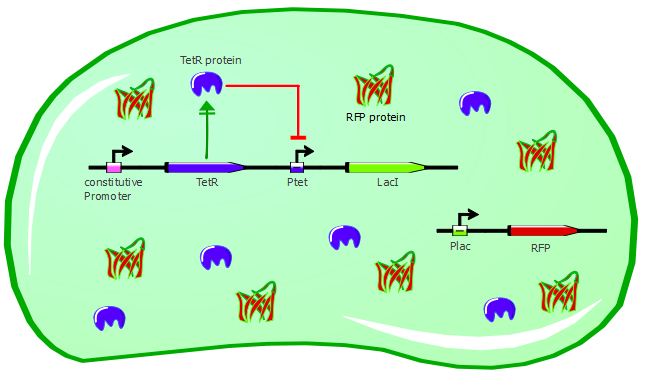
Gene expression in the cells with ATC:
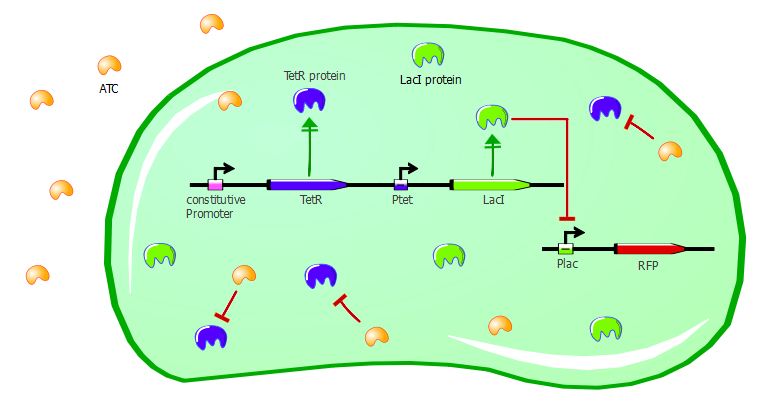
Below you can see the induction curves at different ATC concentrations added to the growth medium:
With zero or low concentrations of IPTG in the cells' medium, RFP expression is quite weak; this can be explained by the fact that Ptet was mutated in our plasmids and thus TetR couldn't repress LacI very efficiently. In normal conditions, we should see RFP expression when TetR binds to Ptet - which is the case here, since we have the wild-type TetR gene. Here, LacI was not well repressed by TetR, thus RFP is repressed even when TetR binds to Ptet. Nevertheless, there is a decrease in RFP expression when we add sufficient amounts of ATC. Even in our mutated system, TetR interaction with Ptet still has an effect on the output. There is a 2-fold difference between high ATC concentrations and zero ATC; we believe that by restoring the Ptet sequence, this difference would be higher.
ATC dose-response curve
This data shows more clearly the difference of normalized RFUs for low or high concentrations of ATC - even if the intensities are low. As in our first readout system, the highest ATC efficiency seems to be reached with 200 ng/microL already.
IPTG induction
IPTG will inactivate LacI, so that RFP will be more highly expressed. From this we expect an increase in RFP expression with increasing IPTG concentration in the medium.
Gene expression in the cell without IPTG:

Gene expression in the cell with IPTG:
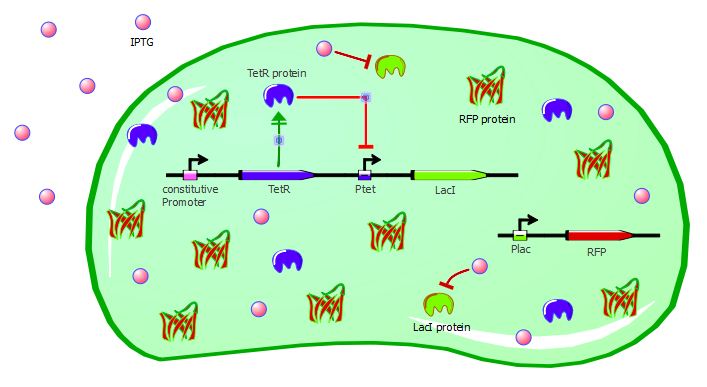
Below you can see the induction curves with different IPTG concentrations added in the cell's medium:
Indeed, RFUs increase 8-fold between zero IPTG and the highest concentrations. Note that the RFU intensity for the curve with no IPTG matches the intensity of the curve with no ATC in the ATC induction experiment, showing that these two experiments are consistent. The curves with the highest IPTG concentrations are not overlapping, showing that we could repress LacI even further at higher IPTG concentrations.
You can compare these results with the characterization of Plac alone. Without IPTG, RFP expression is much lower than the real Plac strength; our system does react strongly to LacI expression.
IPTG dose-response curve
Even if the RFU range is small, there is a clear parallel between RFUs intensities and IPTG dosage. An 8-fold difference between the two extremes can be sufficient for an effective and reliable readout system; however we could use a stronger Plac promoter to get more RFP expression and perhaps a bigger difference.
 "
"
